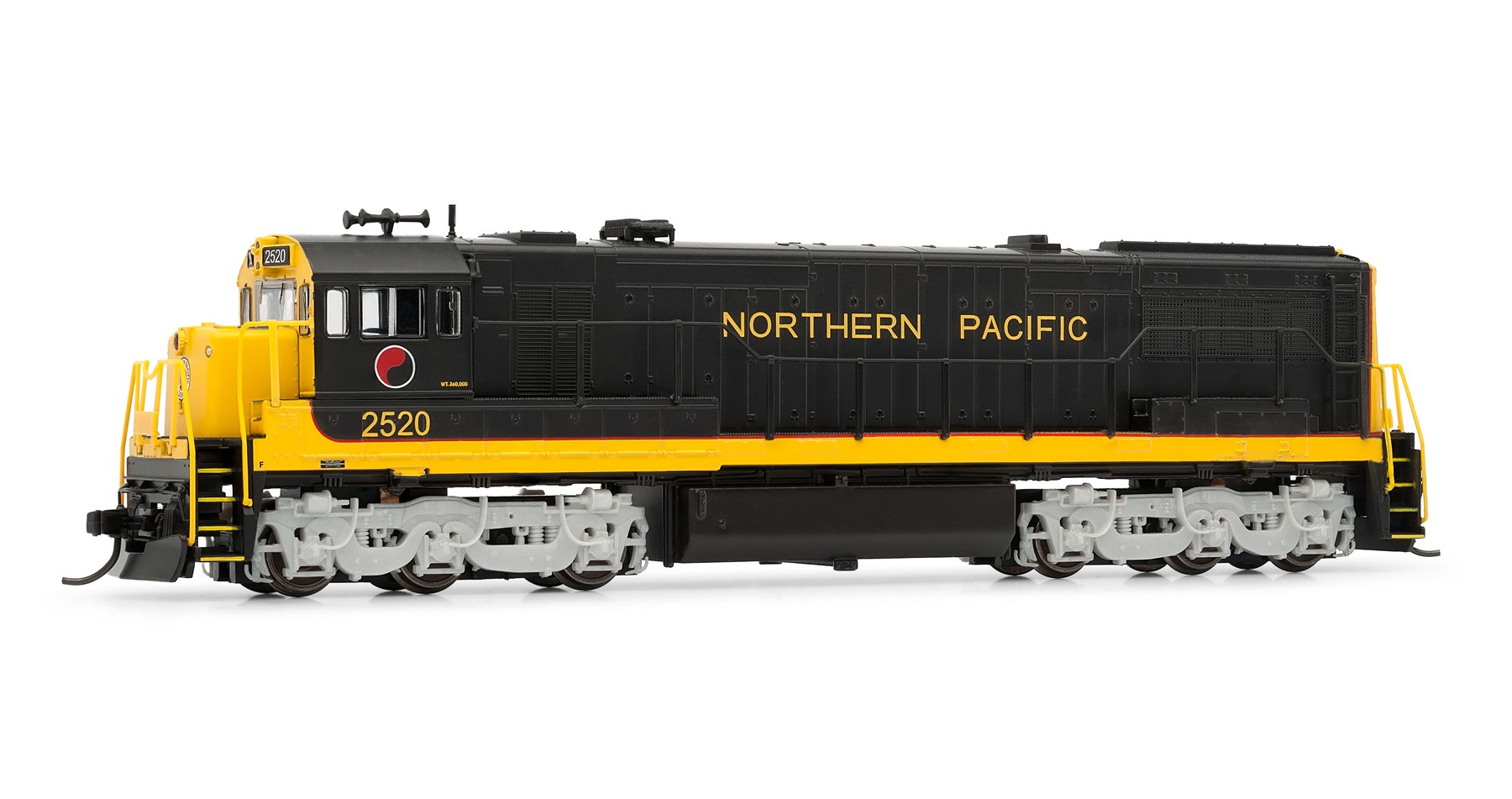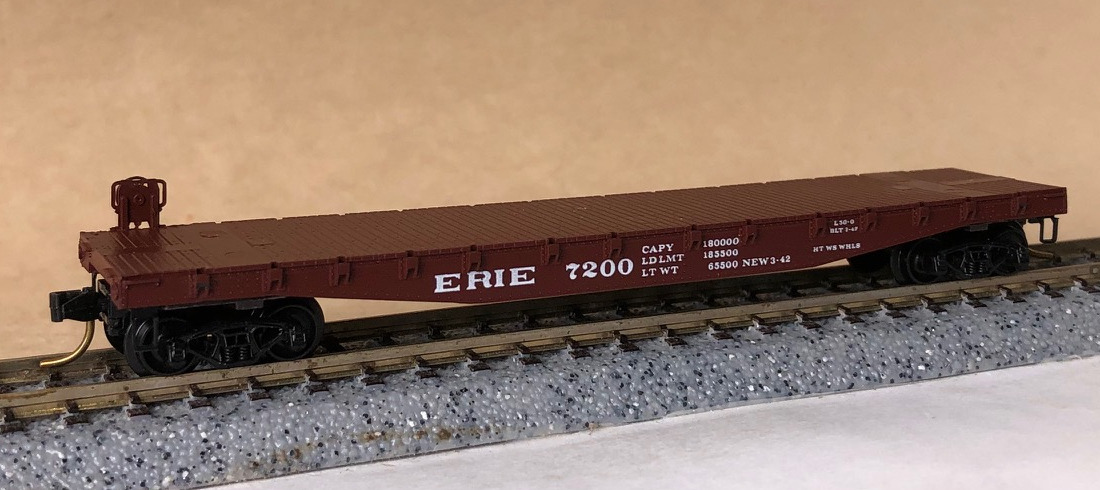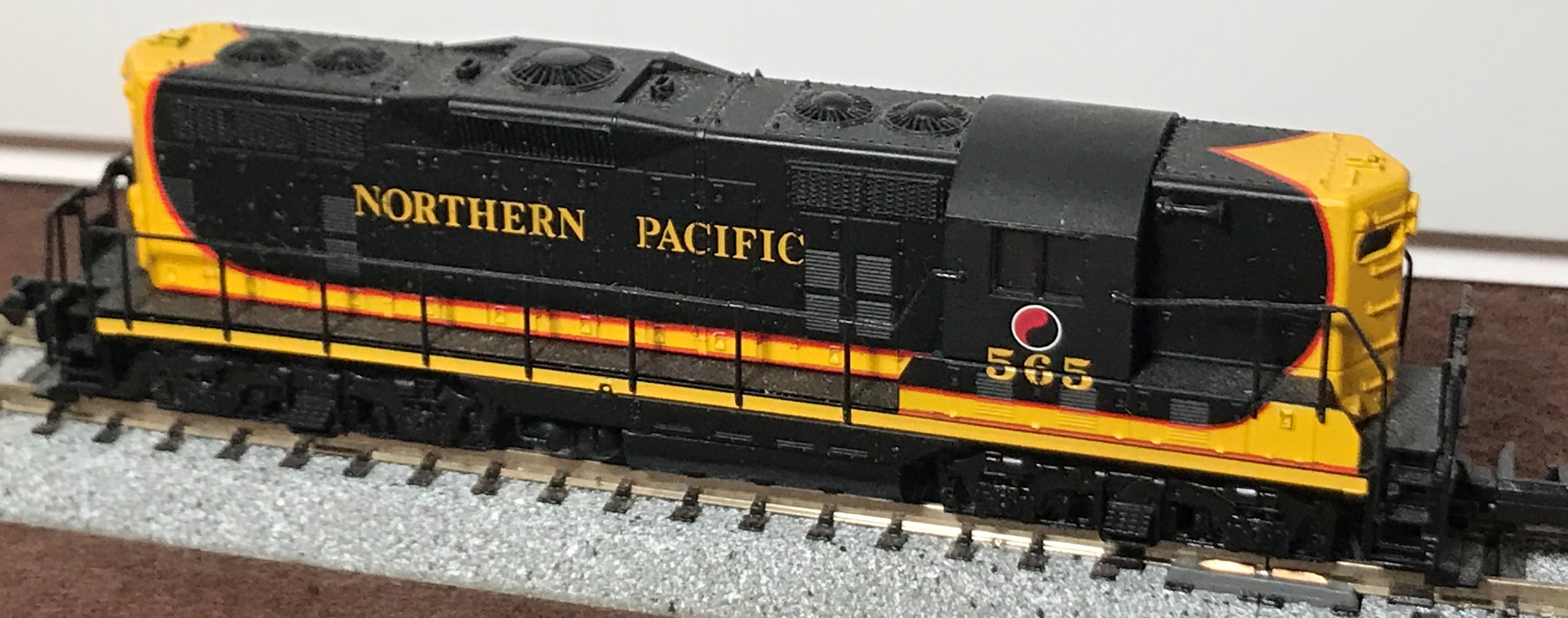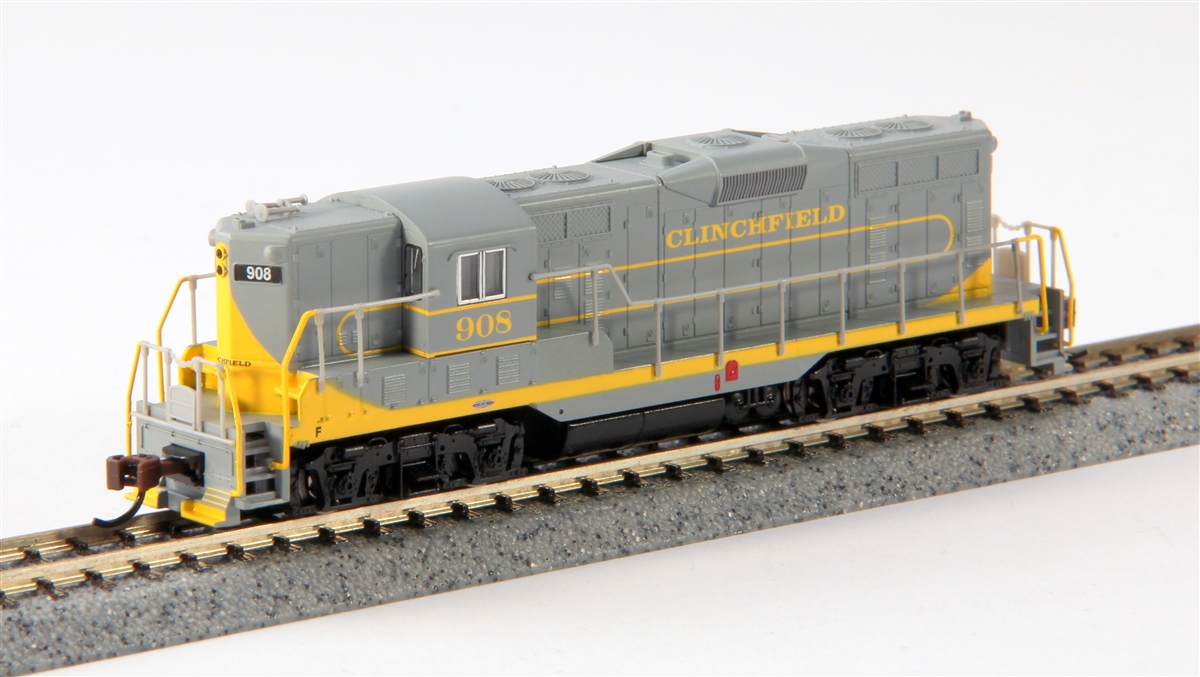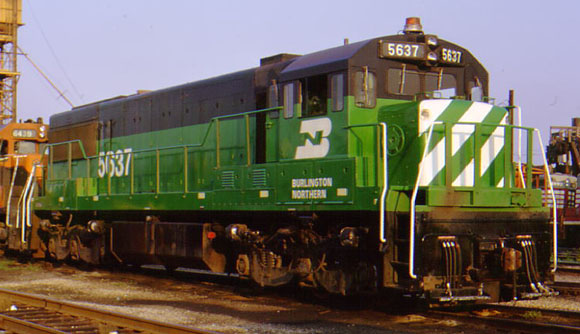Model Information: The Arnold/Hornby GE U25C was released in 2015. They later released the U28C in 2016.
This is a beautiful model with terrific paint and detailing. The lighting scheme is amazing. The model performs excellently, running smoothly and quietly at all speeds, and able to pull 40+ 40' cars without an issue. It uses a 5-pole skew-wound motor with dual flywheels. It also features a very innovative lighting scheme which is quiet cool with constant lighting of the number boards and directional lighting on the head and tail lights.
On the less positive side, as with many other N Scale 6-axle locomotives), the minimum turning radius is 11". Also, the tiny handrails are a bit fragile. To remove the shell, one must unscrew and remove the couplers (which must be handled carefully, or they may fall apart). Overall, this is an excellent model.
On the less positive side, as with many other N Scale 6-axle locomotives), the minimum turning radius is 11". Also, the tiny handrails are a bit fragile. To remove the shell, one must unscrew and remove the couplers (which must be handled carefully, or they may fall apart). Overall, this is an excellent model.
DCC Information: It is DCC Ready, configured to accept standard NMRA 6-pin (NEM 651) decoder.
Prototype History: The GE U25C was General Electric's first independent entry into the United States domestic Diesel-electric locomotive railroad market for heavy production road locomotives since 1936. From 1940 through 1953, GE participated in a design, production, and marketing consortium (Alco-GE) for diesel-electric locomotives with the American Locomotive Company. Starting in 1956 GE launched its Universal Series of diesel locomotives for the export market. The U25C was the first attempt at the domestic market since its termination of the consortium agreement with Alco.
The origin of the U25C grew out of the need for six axle locomotives to operate on a 12-mile heavy haul railroad to construct Oroville Dam. The General Electric salesman to Oro Dam Constructors offered essentially a U25B riding on six axle trucks. When the salesman got back to GE's Erie Plant it was discovered that no six axle U25 was available, nor did GE wish to construct a domestic six axle road switcher until the horsepower threshold reached 3000 horsepower. Rather than lose the four unit sale GE quickly began a design of a six axle U25 that relied heavily on the U25B for engineering. The U25C was longer than the U25B by four feet four inches. The extra length was needed to accommodate the improved Trimount trucks. Completed in September 1963 the U25C was the first six axle unit of the second generation of dieselization. Following quickly on the Oro Dam Constructor's order was an order by Atlantic Coast Line for four U25Cs. The ACL also ordered the first four Alco C628s. Both of these ACL orders were delivered in December 1963.
From Wikipedia
The origin of the U25C grew out of the need for six axle locomotives to operate on a 12-mile heavy haul railroad to construct Oroville Dam. The General Electric salesman to Oro Dam Constructors offered essentially a U25B riding on six axle trucks. When the salesman got back to GE's Erie Plant it was discovered that no six axle U25 was available, nor did GE wish to construct a domestic six axle road switcher until the horsepower threshold reached 3000 horsepower. Rather than lose the four unit sale GE quickly began a design of a six axle U25 that relied heavily on the U25B for engineering. The U25C was longer than the U25B by four feet four inches. The extra length was needed to accommodate the improved Trimount trucks. Completed in September 1963 the U25C was the first six axle unit of the second generation of dieselization. Following quickly on the Oro Dam Constructor's order was an order by Atlantic Coast Line for four U25Cs. The ACL also ordered the first four Alco C628s. Both of these ACL orders were delivered in December 1963.
From Wikipedia
Road Name History:  The Northern Pacific Railway (reporting mark NP) was a transcontinental railroad that operated across the northern tier of the western United States from Minnesota to the Pacific Coast. It was approved by Congress in 1864 and given nearly 40 million acres (160,000 km2) of land grants, which it used to raise money in Europe for construction. Construction began in 1870 and the main line opened all the way from the Great Lakes to the Pacific when former president Ulysses S. Grant drove in the final "golden spike" in western Montana on Sept. 8, 1883.
The Northern Pacific Railway (reporting mark NP) was a transcontinental railroad that operated across the northern tier of the western United States from Minnesota to the Pacific Coast. It was approved by Congress in 1864 and given nearly 40 million acres (160,000 km2) of land grants, which it used to raise money in Europe for construction. Construction began in 1870 and the main line opened all the way from the Great Lakes to the Pacific when former president Ulysses S. Grant drove in the final "golden spike" in western Montana on Sept. 8, 1883.
The railroad had about 6800 miles of track and served a large area, including extensive trackage in the states of Idaho, Minnesota, Montana, North Dakota, Oregon, Washington and Wisconsin. In addition the company had an international branch to Winnipeg, Manitoba, Canada. The main activities were shipping wheat and other farm products, cattle, timber and minerals; bringing in consumer goods, transporting passengers; and selling land.
The company was headquartered first in Brainerd, Minnesota, then in Saint Paul, Minnesota. It had a tumultuous financial history, and in 1970 it merged with other lines to form the Burlington Northern Railroad.
Read more on Wikipedia.

The railroad had about 6800 miles of track and served a large area, including extensive trackage in the states of Idaho, Minnesota, Montana, North Dakota, Oregon, Washington and Wisconsin. In addition the company had an international branch to Winnipeg, Manitoba, Canada. The main activities were shipping wheat and other farm products, cattle, timber and minerals; bringing in consumer goods, transporting passengers; and selling land.
The company was headquartered first in Brainerd, Minnesota, then in Saint Paul, Minnesota. It had a tumultuous financial history, and in 1970 it merged with other lines to form the Burlington Northern Railroad.
Read more on Wikipedia.
Brand/Importer Information: Founded in 1906 by Karl Arnold in Nürnberg, K. Arnold & Co. began its life producing tin toys and related items. They produced an extensive line of model ships, doll house items and other toys. In 1935, K. Arnold & Co. hired Max Ernst as their managing director. Ernst, not to be confused with the German realist artist of the same name, was a significant factor in the future of Arnold.
On Max Ernst's 1976 retirement, Arnold employed perhaps 200 to 250 people, using three facilities in the Nuernberg area. The Company continued under family control until 1995, when Arnold went into bankruptcy and was sold to Rivarossi of Italy. Rivarossi, in turn, also went bankrupt, leading to the sale of all assets to Hornby of the United Kingdom. Production is carried out in China.
From Wikipedia
On Max Ernst's 1976 retirement, Arnold employed perhaps 200 to 250 people, using three facilities in the Nuernberg area. The Company continued under family control until 1995, when Arnold went into bankruptcy and was sold to Rivarossi of Italy. Rivarossi, in turn, also went bankrupt, leading to the sale of all assets to Hornby of the United Kingdom. Production is carried out in China.
From Wikipedia
Item created by: gdm on 2016-04-27 09:38:24. Last edited by George on 2024-01-26 20:28:58
If you see errors or missing data in this entry, please feel free to log in and edit it. Anyone with a Gmail account can log in instantly.
If you see errors or missing data in this entry, please feel free to log in and edit it. Anyone with a Gmail account can log in instantly.


